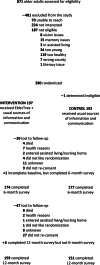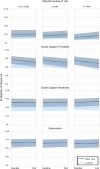Effect of an eHealth intervention on older adults' quality of life and health-related outcomes: a randomized clinical trial
- PMID: 34100234
- PMCID: PMC8183591
- DOI: 10.1007/s11606-021-06888-1
Effect of an eHealth intervention on older adults' quality of life and health-related outcomes: a randomized clinical trial
Abstract
Background: By 2030, the number of US adults age ≥65 will exceed 70 million. Their quality of life has been declared a national priority by the US government.
Objective: Assess effects of an eHealth intervention for older adults on quality of life, independence, and related outcomes.
Design: Multi-site, 2-arm (1:1), non-blinded randomized clinical trial. Recruitment November 2013 to May 2015; data collection through November 2016.
Setting: Three Wisconsin communities (urban, suburban, and rural).
Participants: Purposive community-based sample, 390 adults age ≥65 with health challenges.
Exclusions: long-term care, inability to get out of bed/chair unassisted.
Intervention: Access (vs. no access) to interactive website (ElderTree) designed to improve quality of life, social connection, and independence.
Measures: Primary outcome: quality of life (PROMIS Global Health). Secondary: independence (Instrumental Activities of Daily Living); social support (MOS Social Support); depression (Patient Health Questionnaire-8); falls prevention (Falls Behavioral Scale). Moderation: healthcare use (Medical Services Utilization). Both groups completed all measures at baseline, 6, and 12 months.
Results: Three hundred ten participants (79%) completed the 12-month survey. There were no main effects of ElderTree over time. Moderation analyses indicated that among participants with high primary care use, ElderTree (vs. control) led to better trajectories for mental quality of life (OR=0.32, 95% CI 0.10-0.54, P=0.005), social support received (OR=0.17, 95% CI 0.05-0.29, P=0.007), social support provided (OR=0.29, 95% CI 0.13-0.45, P<0.001), and depression (OR= -0.20, 95% CI -0.39 to -0.01, P=0.034). Supplemental analyses suggested ElderTree may be more effective among people with multiple (vs. 0 or 1) chronic conditions.
Limitations: Once randomized, participants were not blind to the condition; self-reports may be subject to memory bias.
Conclusion: Interventions like ET may help improve quality of life and socio-emotional outcomes among older adults with more illness burden. Our next study focuses on this population.
Trial registration: ClinicalTrials.gov ; registration ID number: NCT02128789.
Keywords: depression; eHealth; older adults; quality of life; telemedicine.
© 2021. The Author(s).
Conflict of interest statement
David H. Gustafson Sr. has a small shareholder interest in CHESS Health, a corporation that develops healthcare technology for patients and family members struggling with addiction; this relationship is managed by Dr. Gustafson and the UW–Madison’s Conflict of Interest Committee. No other disclosures are reported.
Figures




References
Publication types
MeSH terms
Associated data
Grants and funding
LinkOut - more resources
Full Text Sources
Medical

